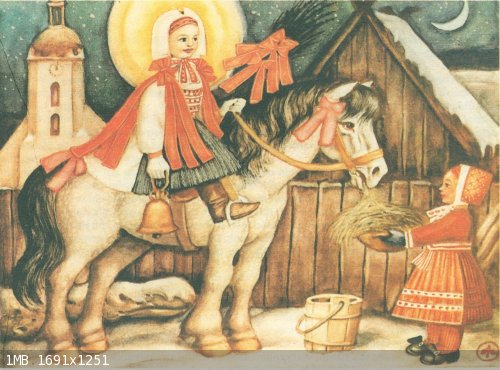Wendish Folklore Portfolio 13. DŹĔĈETKO - The Gift Child
13. DŹĔĈETKO - The Gift Child
Translated by Elmer Hohle

The period prior to Christmas was always filled with anticipation and mystery. It was profitable for the children to be on their best behavior, for in
the twilight of the evening, a wonderfully, beautifully clad figure would frequently appear in the little villages around Schleife. Its face was
covered, and it was accompanied by two maidens clad in native costumes. It was the "Child Present Giver," and it gladdened the hearts of the children
by giving them various sweet treats and Christmas pastries. It was a predecessor of the later custom of Ruprecht. It was dressed up by the ladies of
the spinning room.
Thus, for more than a century, the Gift Child was promulgated in this way: A talkative, lively girl was chosen and dressed up by her friends. Her
upper body was covered with a man's shirt. A blue apron was tied over her underwear and clothes. White stockings, black shoes, a knitted scarf, and a
bonnet were put on her. Her face was covered with a see-through veil, and on the head was placed a little wreath. Chest, arms and back were covered
with a mantle that had various colored silk bands pinned on it.
Both hands wore white gloves. In the left hand she carried a folded cloth, containing little gifts, and a bell; but in the right a switch from a green
birch bough. A costumed girl walked along on each side. (According to Miercin-Novak's print, she must have ridden on a pony - [Hohle's opinion]) Thus
they moved from house to house, wherever children resided. The children sat still on the oven bench. The Gift Child came in without saying a word,
bowed, and then struck with her switch everyone, except the children - they were given gifts of apples, nuts, sweets and pastries.
To this day, the Gift Child still goes about the villagers who are members of the church at Schleife, dressed much the same as back then. Each
locality entwined its own peculiarities to the costume. Instead of bands, sometimes pinned on bows were used.
Different from the Ruprecht, who struck misbehaving children, only the adults were struck with the switch. The manner it was done in our localities
can readily be explained by the introduction of our belief. At the time of the turning point of the winter sun (Winter Solstice), nature appeared to
them as having mysterious powers, which were preparing anew the growing season. Such powers were hiding in the buds and branches of our trees and
shrubs. If you touched person with a switch from a fresh birch bough, the hidden growth-magic would transfer to the person.
|